The way to develop and launch a successful PR strategy has changed.
In this guide, you’re going to learn how strategic PR can help your business grow in 2024.
More specifically, here are some of the questions we’re answering:
- What is a public relations (PR) strategy?
- Why does your company need a PR strategy?
- How do you create a PR strategy (without breaking the bank)?
- What are some of the best PR tools you can use to implement your strategy?
We’ve got a lot to cover, so let’s get started.
Link building cheat sheet
What is a PR Strategy?
A PR strategy is aimed at improving your brand’s image.
It is the collection of all actions taken in order to get publicity and coverage of your brand on relevant media outlets, industry publications, podcasts, as well as blog and social media posts, and reach both your short-term and long-term PR goals.
In a sense, it is quite similar to a marketing strategy since it is all about spreading a message about your brand, but without the business goals that necessarily involve sales.
In most situations, a public relations strategy is used to spread the word about your business, services, or products to improve their recognition and maintain positive relationships with your audience and stakeholders.
But it has another use: crisis management.
Mending a situation in which your brand’s image has suffered an impact.
An example of such a crisis would be a data leak, or an employee doing something illegal or shady.
There are three types of media channels, useful for managing public relations: owned, paid, and earned.
Type #1: Owned Media
Of course, the first place to talk about yourself would be your own resource.
Your blog, landing pages, YouTube channel, LinkedIn and other social media groups are where you should focus on first.
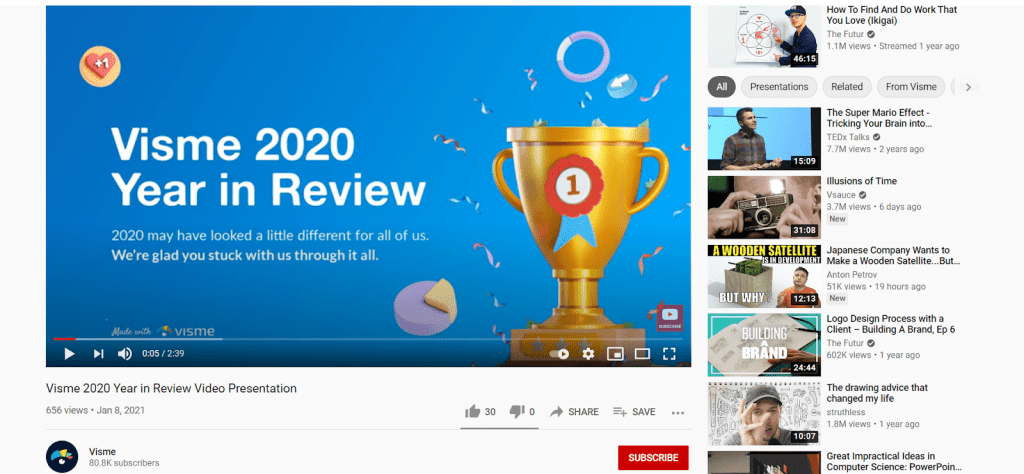
This is the easiest channel to manage since you have total control over it.
It is also the most important because, well, in order to be viewed as a trustworthy brand, you have to present yourself accordingly.
Also, 99% of your brand’s mentions will link to one of your owned media pieces, so it might be your only chance to impress them.
That’s why every single of your owned media posts should be top-notch.
Type #2: Paid Media
This includes everything you paid for to get exposure. PPC, paid advertisements, sponsored posts, influencers, etc.
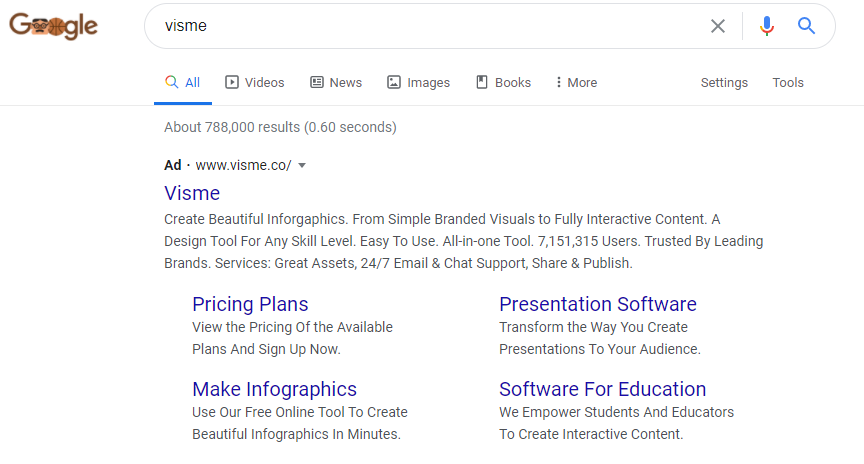
And even though people generally don’t like advertisements, this is the most sure-fire way to get them to notice you.
Type #3: Earned Media
Earned media coverage is the hardest to get, but it is also probably the one that matters the most.
Thought leaders’ and bloggers’ reviews, mentions, contests, shares, word of mouth recommendations, and even high Google rankings are all considered earned media. As PR expert, Dan Fries of BlueTree states, “High-quality PR mentions build customer trust and improve brand reputation.
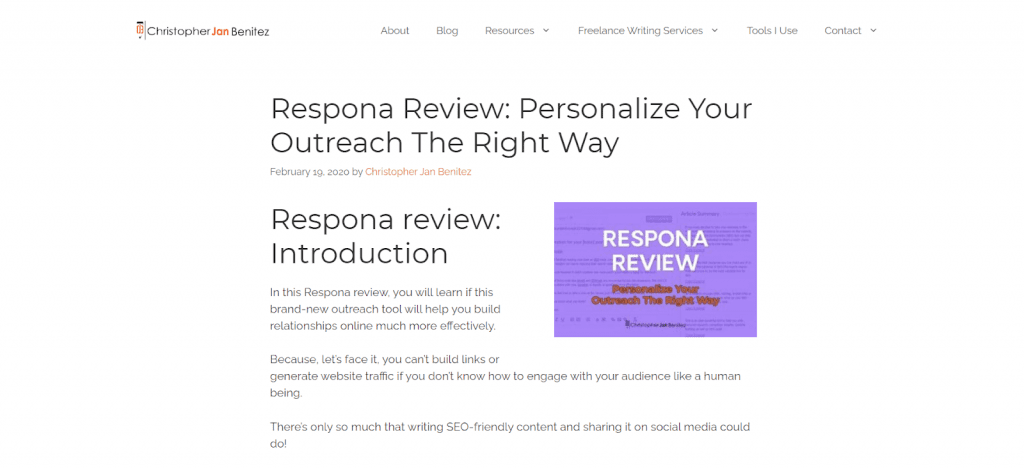
A healthy PR strategy makes use of all three types of media channels.
If you only focus on owned media, you will struggle to gain any traction whatsoever. Investing all of your resources into paid media will drive people to your site, but they will be unlikely to stay and browse your content/products because it’s underdeveloped.
Without strong content of your own it will also be extremely difficult to rank high in Google or to get other bloggers to link to you simply because there’s nothing link-worthy.
So, all three channels synergize and work together to get you closer to your ultimate goal: get exposure.
Why (& When) Your Company Needs a PR Strategy?
There is no set condition when you can look at your business and say “Now, it is time to develop a PR strategy.
In fact, every brand needs a public and media relations strategy developed as soon as possible.
Without any kind of promotion, you can not expect people to start talking about you.
You might have the best product in the whole wide world, and still be unknown to the masses.
It is impossible to oversell the importance of a PR strategy.
But the argument that you will fail to gain any kind of attention without public relations is awfully vague.
So, let’s dissect some concrete goals that a PR strategy will help you achieve. Starting with the most obvious one:
Reason #1: It helps improve brand awareness
I already mentioned it, but first and foremost, public relations serve as a tool for boosting your brand’s awareness.
The more people know about you, the better it is for you.
That, of course, applies to good PR.
But, as some celebrities say, any PR is good PR, so even if some kind of controversy sparks around your company, you can take advantage of the increased publicity and turn the tables around completely.
Reason #2: Crisis management
Speaking of bad publicity, a solid PR campaign is what will help you recover your image should something bad happen to it.
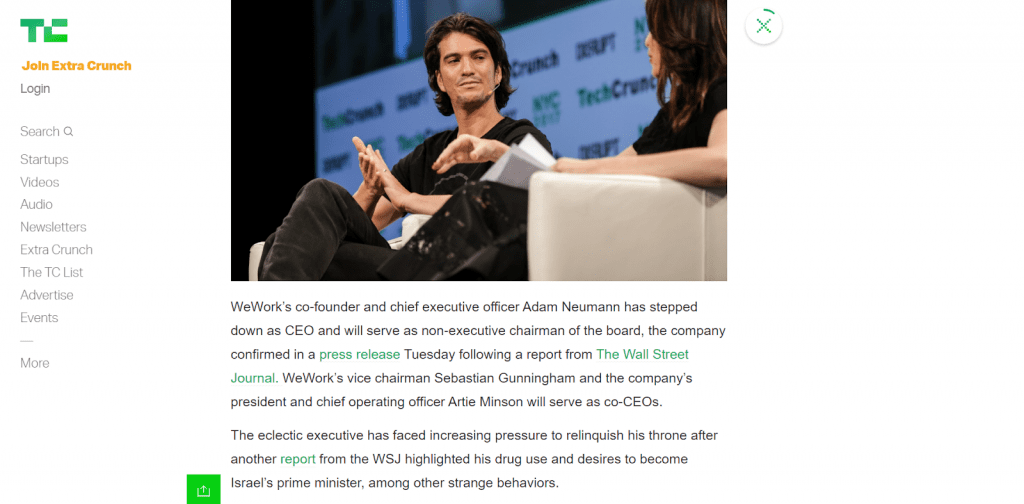
Public relations are essential to managing a crisis since without you addressing the issue, the last thing your audience will remember about you is the negative event that caused it.
And that can mean the end to your brand. In a sense, it is the life vest that will keep your business afloat even if the current may feel overwhelming.
Reason #3: It helps you build trust
One of a PR strategy’s goals is to help you establish a solid brand identity and use messaging that reflects your company’s value.
Once people start associating you with your product/service (just like when people say “Let me Google something” instead of “let me use a search engine to look for something”), that is a good indicator of amazing branding.
A good PR strategy will also help establish stronger bonds with your existing customers (as well as attract new ones), which is perfect for reducing churn.
Reason #4: It helps you generate leads
And even though the purpose of PR isn’t focused on generating revenue (that’s the job of marketing), a good public relations strategy definitely helps generate more leads.
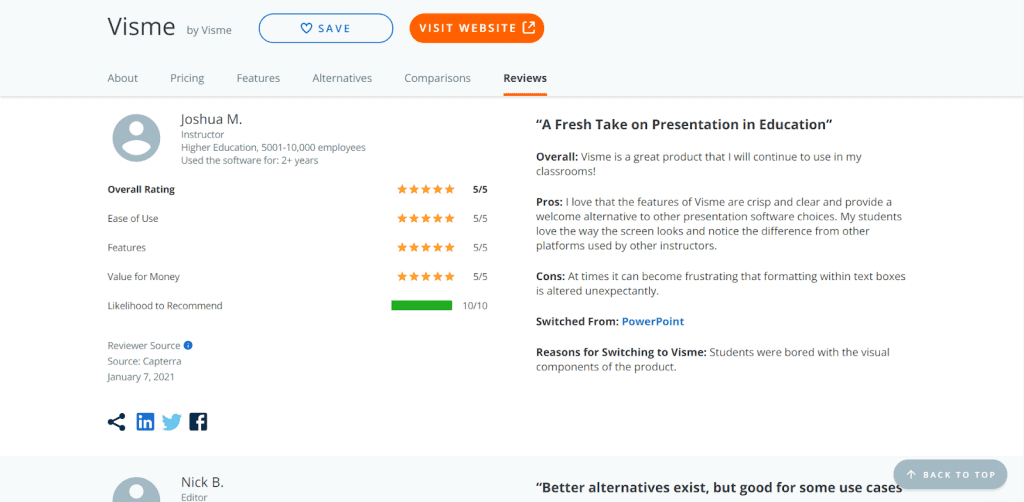
Since you’ll be getting your product in front of more people, naturally, more people will be interested in buying it, or at least trying it out.
Reason #5: It helps attract investors
Whenever investors see a business that has all the potential to conquer the market, they see an opportunity.
And an opportunity is exactly what you want to look like to them.
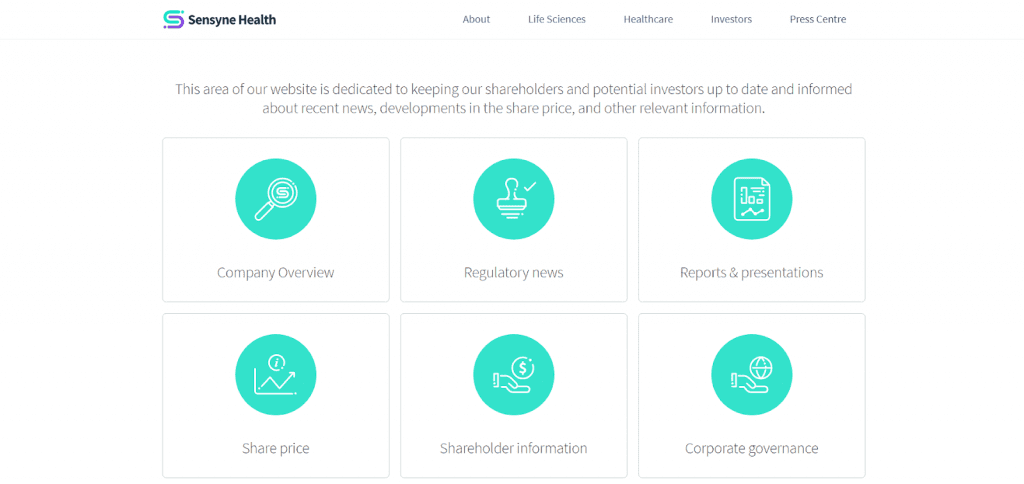
They will, in turn, help you develop your brand even further, increasing your credibility and entrenching your position on the market.
Reason #6: It helps attract employees
If you position yourself as a powerful, trustworthy brand, in addition to customers and investors, your PR strategy will also serve to attract new talent to your office.
And, as your business grows, so do its requirements, and at some point you will need to expand your team.
A good PR strategy practically takes care of that need automatically, saving you the trouble of running a separate hiring campaign.
They will come to you by themselves!
So, a PR strategy helps your business grow in all possible ways, from generating more leads to attracting investors and even employees.
Without a good strategy you will practically be running your business in the dark, and without promoting it in some way, all of your efforts will be practically wasted.
So, now we have established the importance of a public relations strategy for your business.
Now, let’s take a look at an example of great PR.
Example of great PR: Apple
Being one of the largest, most successful companies to have ever existed, Apple has completely mastered the art of public relations and gained absolute thought leadership.
In fact, they let their customers do it for them.
After all, people are much more likely to purchase a product that their friends have recommended to them rather than one they saw in a pompous ad.
But how do they do it?
Well, of course, their reputation plays a considerable role, but there is a little PR trick they use every time they release a new product.

Apple is also the master of trailers and teasers.
Even if you’re more of an Android person, their iPhone 12 trailer probably still hyped you up.
Besides, of course, the obvious production value of the whole thing, Apple included some pretty exciting details about the smartphone, including the fact that it uses the fastest mobile chip in the world, films in 4K, and is considerably more drop-resistant.
But, they didn’t actually mention when the iPhone was going to come out, and how much it was going to cost, leaving the audience talking about how cool it’s going to be and how much they hope it’s not going to take too long until release.
Luckily for the excited fans, iPhone 12 released only 10 days after this trailer.
What they didn’t realize, though, was that by telling their friends and family about it, they were essentially part of Apple’s PR efforts.
This is how Apple handles PR for new releases—tease the audience with exciting little videos that don’t reveal too much (just the key messages), let them build up the hype, and only after that delve into a full-blown marketing campaign.
But, of course, a trailer was far from the only PR move Apple did preparing for the launch of iPhone 12.
The same day as the trailer I mentioned above, they also published a full-on press release on their own Newsroom, which attracted the attention of countless other media outlets, reviewers, and influencers.
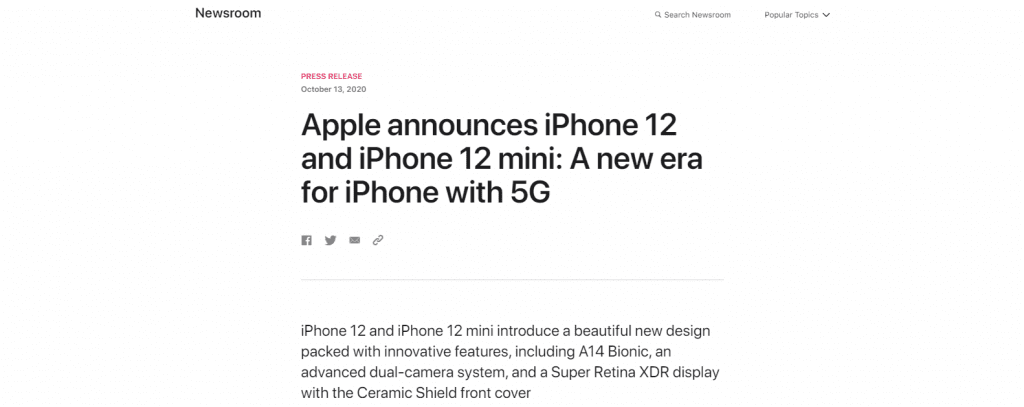
Just with these two tactics, the company managed to utilize every type of media:
Owned, paid, and earned.
- Owned: The publication of the trailer and press release on their own YouTube channel and blog
- Paid: Paid advertisements, and showcasing this trailer on TV, Netflix, etc.
- Earned: Smaller news outlets covering iPhone 12’s specifications on their own blogs, influencers and bloggers talking about it in their videos and social media, and even your friend chewing your ear off about how much they’re excited for it.
Simply brilliant.
But, unfortunately, maintaining effective public relations for a smaller company (especially when it comes to startup PR) is a matter of many more PR activities than just videos and press release distribution.
The good news is, though, that it’s very much possible, and I will tell you exactly how to do it.
How Do You Create a PR Strategy In 5 Simple Steps
Actually, there are two ways to create a PR strategy.
The first would be hiring a PR agency to do it for you.
Sure, it is much easier and a lot more convenient, but it has some considerable downsides.
The first one, of course, is that hiring an agency is quite expensive, especially if your budget is tight.
The not-so-obvious disadvantage of having a PR firm develop a strategy for you is the fact that you won’t be learning anything from it.
And there’s nothing more valuable for your business than first-hand knowledge and experience, which you can only gain by handling PR yourself.
So, the process we’re going to present makes sense only if you choose to do PR in-house.
So, let’s take a look at the 5-step process of building a PR strategy with our own public relations tool, Respona.
Step #1: Identify your target audience
If you’re familiar with PR or marketing, you already know that the first step to any kind of campaign would be to define your target audience, and find prospects.
Respona makes it very easy to do.
It has a built-in search engine, which allows you to easily find other resources, blogs, news articles, influencers, and even podcasts (that you can come on as a guest) with the right audience demographics for your purposes.
Respona has specialized campaign templates for each of these purposes:
Let’s start with a news outreach campaign.
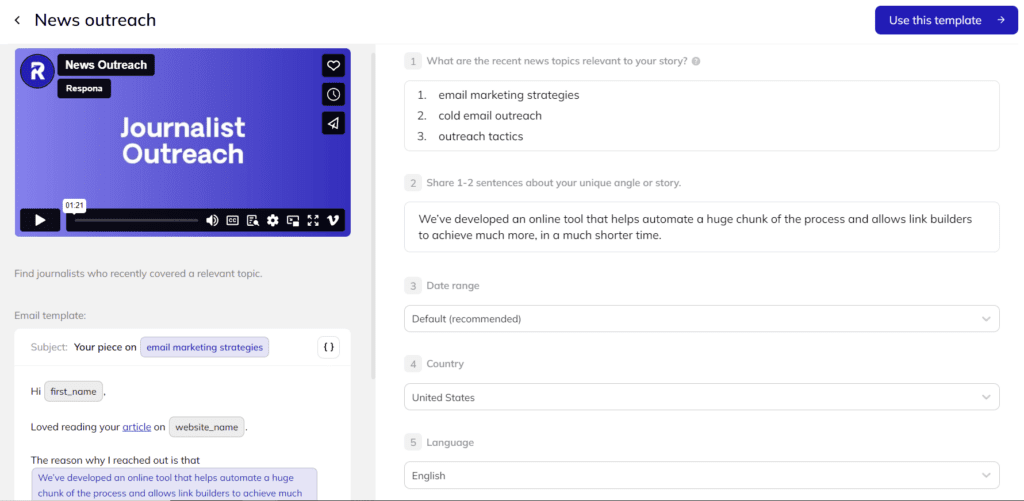
To use it, you’ll only need to fill out a few necessary fields (and some optional).
In the first field, enter some keywords that are relevant to your business.
These will be used to find related news articles.
In the second field, enter a brief description of why you’re reaching out to your prospect, such as the summary of your study’s results.
The date range field is optional. If you keep it at default, Respona will automatically find the freshest news articles.
In the fourth one, you can select the location of your results to narrow down the results to only your country.
The language field is quite self-explanatory.
Last but not least, you may also enter specific news websites like Forbes.com in the sixth field to narrow down the results even further:

Click “Use this template” to enter the campaign editor and move on to the next steps, which are preparing your email sequence, finding opportunities and contacts associated with them, and, of course, personalizing pitches.
We’ll walk through them later – for now, let’s talk about some other strategies for your PR campaign.
Step #1.1: Search for “Best x” blogs and podcasts
I’ve shown you how to look for news articles. But “Top x” blog posts and podcasts are amazing opportunities to gain exposure as well.
To find listicles, simply pick the “Listicle” campaign template and fill out 5 simple fields:
- Your product name
- Keywords that are relevant to your company and what you do
- Your most prominent competitors
- What sets you apart from your competitors
- Incentives for your prospects to collaborate
Respona will automatically apply the most common combinations of “top x”, “best x”, etc. article names to find relevant listicles for you to get featured on.
But more on that later.
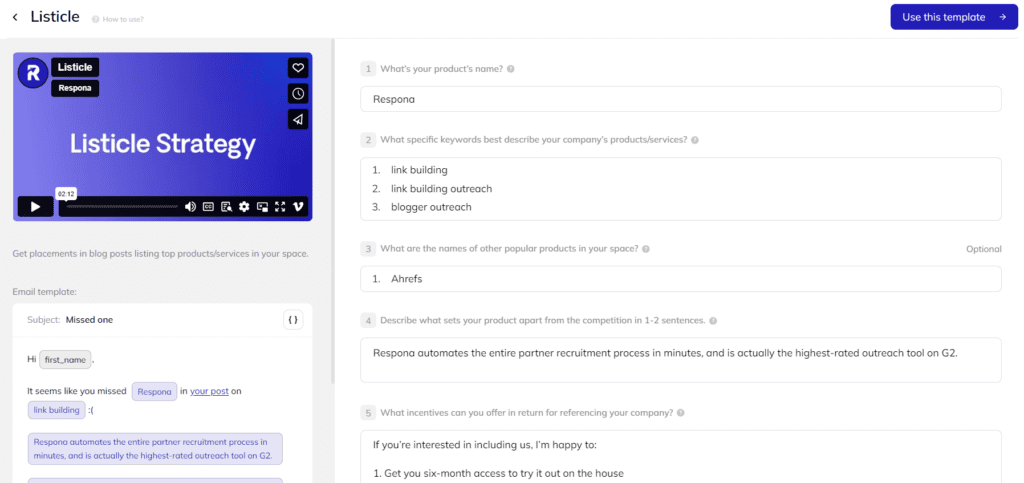
Finding podcasts is equally as simple. Pick “Podcast Outreach” from the campaign template list and fill out its three fields:
- General topics of podcasts you’d like to become a guest on
- 1-2 sentences about your career accomplishments
- The exact topics you’re interested in talking about
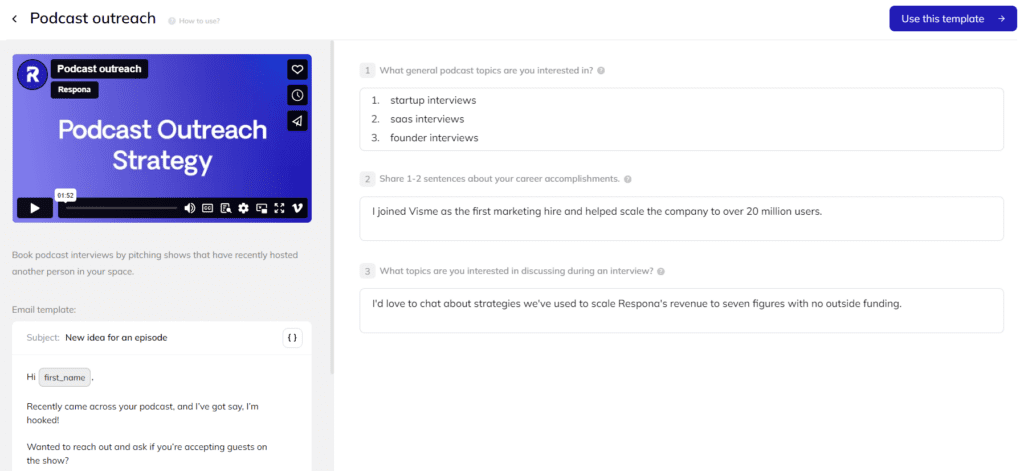
Step #1.2: Extract backlinks to competitors and reach out to those sites
For this tactic, you will need to use another campaign template – Skyscraper technique.
Respona is integrated with Moz by default, which is where the backlink data will be pulled from.
Alternatively, if you already have an account with Ahrefs or Semrush, you may connect it to Respona and use that as a source instead.
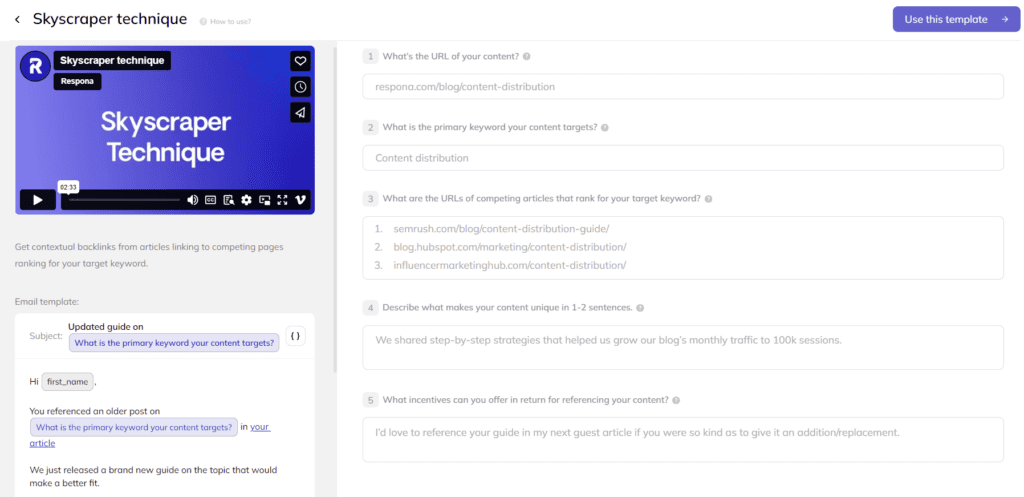
Simply enter the URL of the content you’d like to promote, your target keywords, links to your competitors, as well as a brief description of your aricle along with an incentive for your prospect to collaborate.
Respona will automatically pull the backlinks pointing to your competitors and add them straight to your outreach campaign.
Click “Use this template” when all fields are filled out.
Which brings us to the next step.
Step #2: Prepare your email pitch
Now, it is time to craft your email pitch.
Respona has pre-built email templates for each of the campaign types but we will be creating a new sequence specifically for PR outreach.
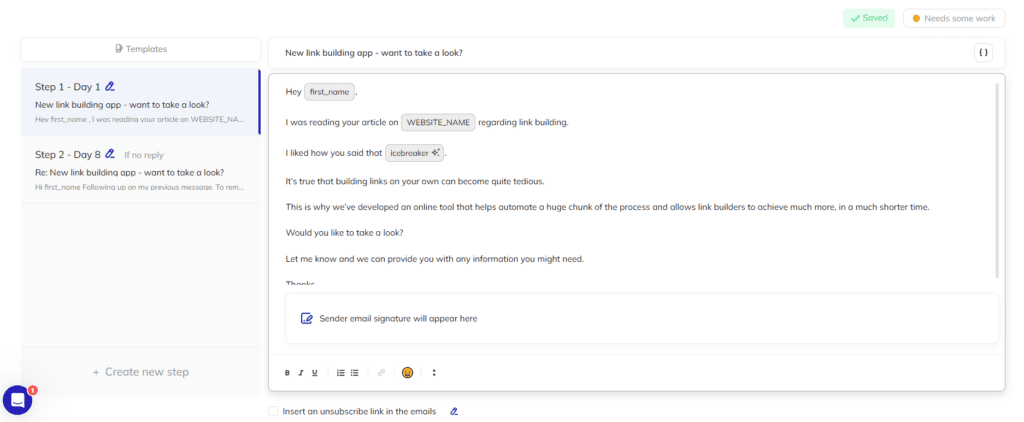
To make the most out of your template, try to make it as re-usable as you possibly can.
And even though there are no be-all-end-all tactics for writing an email that gets opened 100% of the time, there are definitely a few things that can improve your chances.
- Be clear as to who you are and what you want to achieve with the email;
- Keep your subject line as short and descriptive as possible;
- Avoid spam words (here, now, affordable, buy, etc.);
- Include a relevant call-to-action.
As you can see, I’ve used quite a few variables in it (the weird code highlighed in grey).
Variables adjust to each opportunity in the campaign, so you can spend less time on the personalization stage.
So, for example, the {website_name} variable will insert the name of your prospects’ websites for each individual pitch.
The most interesting variable here is the icebreaker.
It’s an AI variable that will automatically pull your prospects’ article summaries into the content for quick but meaningful personalizations.
You can provide additional instructions for the AI in the following steps.
Here’s the full template for you to grab and use during your own campaigns:
Subject: Subject
Hey {first_name},
I was reading your article on {website_name} regarding link building.
I liked how you said that {Something from the article}.
It’s true that building links on your own can become quite tedious.
This is why we’ve developed an online tool that helps automate a huge chunk of the process and allows link builders to achieve much more, in a much shorter time.
Would you like to take a look?
Let me know and we can provide you with any information you might need.
Thanks,
{email_signature}
Respona also rates your pitch and approximates your chances of getting a response. It does so by checking your subject length, word count, number of questions, and, of course, scans it for spam words.
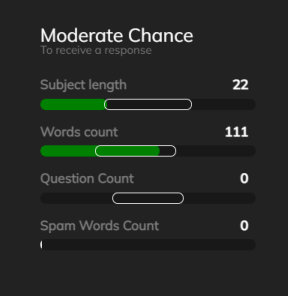
Don’t get discouraged if you don’t get too many responses right away.
In fact, Respona can send out automatic follow-ups if your prospects don’t reply, so let’s set it up.
To add a follow-up message, press “Create New Step”.
Let’s set our follow-up for 5 business days after the initial email.
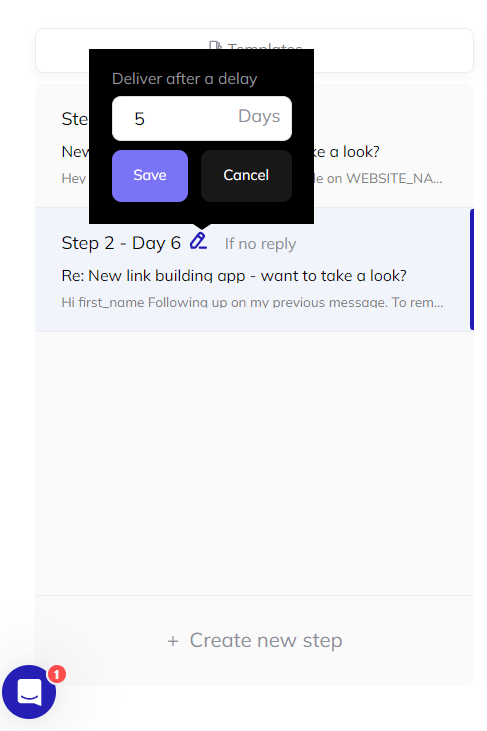
You can add as many follow-ups as you want, but I advise sticking to one or two.
Stay mindful of their time, and if your prospect hasn’t responded to three of your emails, chances are, they are not interested anyway.
Once you’ve set up your initial email and follow-ups, you can move on to the next step.
Step #3: Find opportunities and their contact information
Respona has a built-in search engine and an email finder, so you no longer need to use manual prospecting or other tools like Hunter.
It’s pretty straightforward, and the process is highly automated, running multiple queries and pulling relevant opportunities into your campaign, in real-time.
Let’s walk through the process.
Depending on the campaign template you used, the search strings will look a little different, but they will all be pre-built for you depending on your inputs on the campaign template screen.
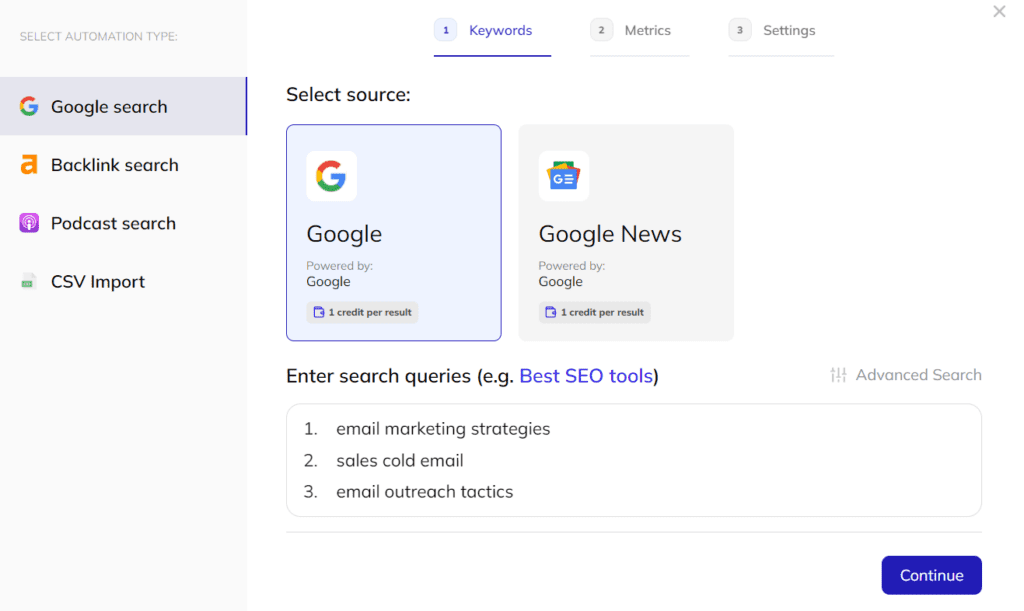
This is what it looks like for news outreach.
No need to do much here besides click “Continue” and set some additional SEO filters to narrow down your opportunities.
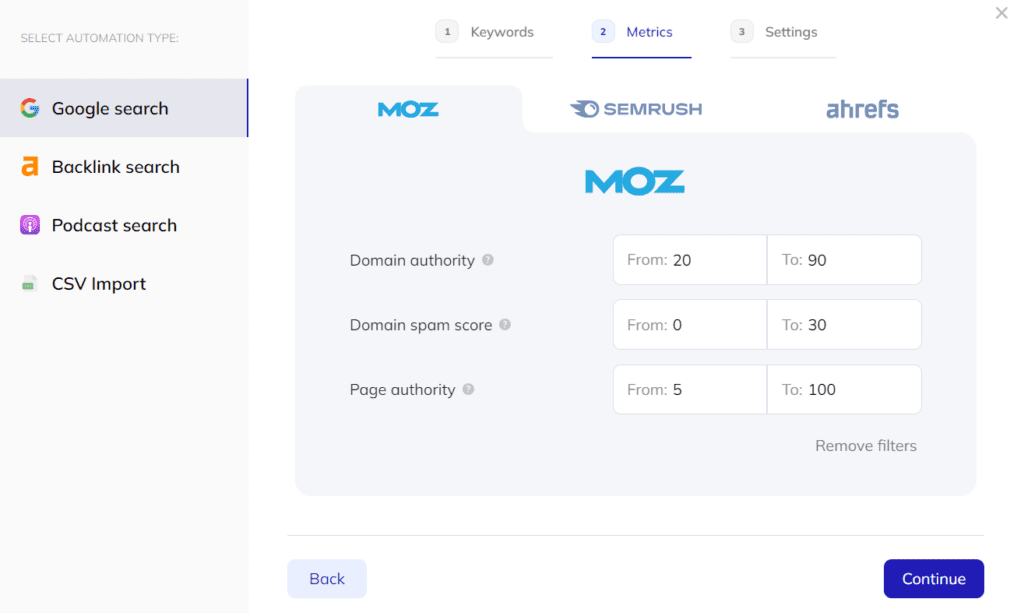
Next, there are a few advanced functions.
The first one is the email finder, which is also already locked and loaded to find journalist contacts, skip catch all-domains, as well as generic emails, ensuring that all contact information you find is used by PR reps.
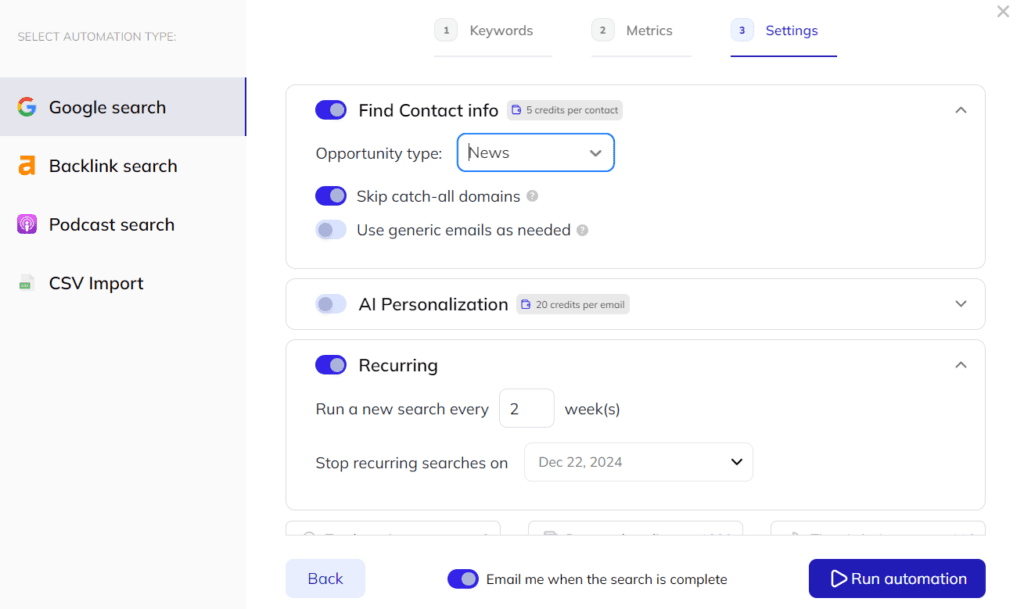
Next, let’s feed our AI personalizations some guidelines to use short sentences, avoid commas, and stick to a 5-th grade reading level to not overwhelm our prospects with essays.
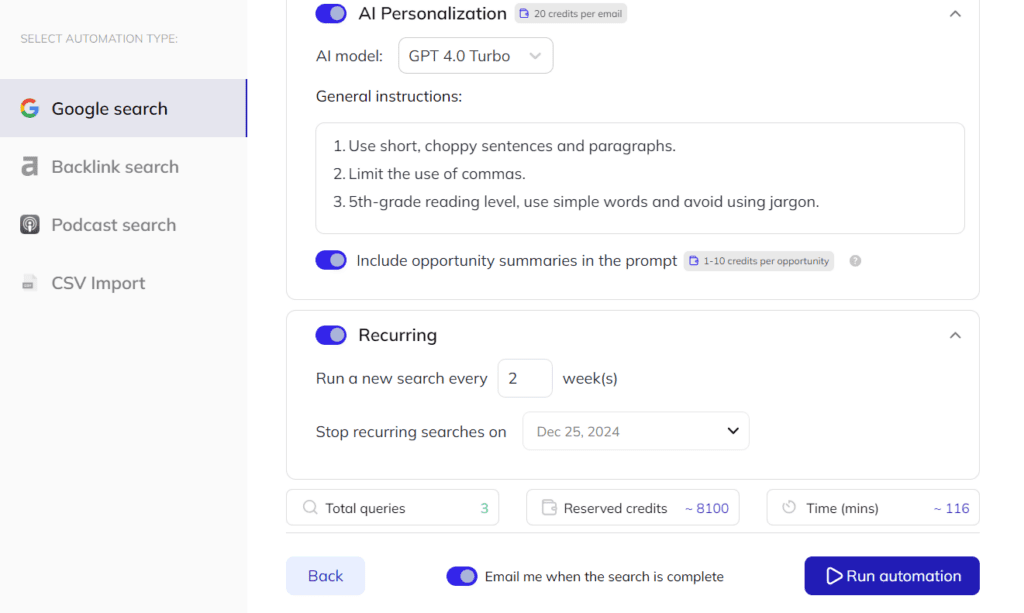
Finally, let’s also turn our search into a recurring one – enabling Respona to re-run it every couple of weeks so that we always have fresh opportunities in our campaign.
When ready, click “Run automation”.
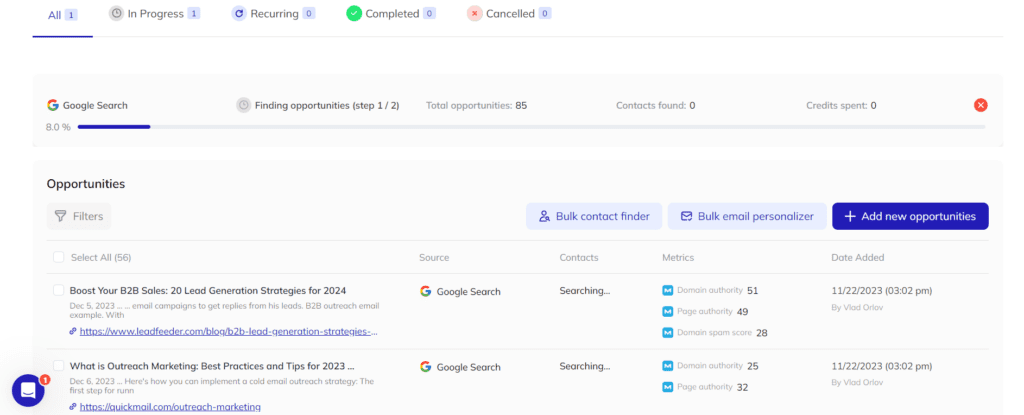
Results will start appearing on your screen as they are found.
You don’t need to wait for the whole search to be completed to start personalizing pitches to save a little bit of time.
Which segways into the next step.
Step #4: Personalize your pitches and launch the campaign
Now, it’s time to personalize your pitch for every single opportunity.
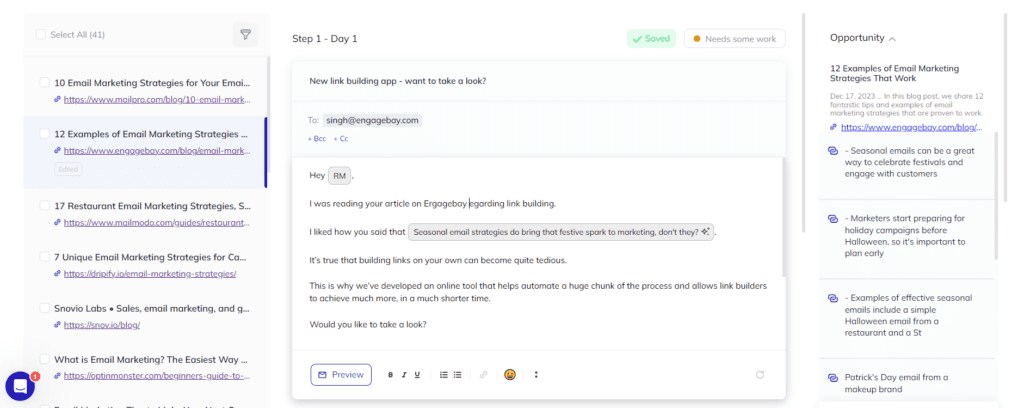
All variables used will be automatically populated at this step – including AI icebreakers.
However, we encourage you to also give your emails a more personal touch to increase your chances of success even further.
On the right side of the screen, you will also find short excerpts from your prospect’s content so that it’s even easier to find something to mention.
When you’ve personalized every single pitch, you can launch your campaign.
Step #5: Measure the results and tweak your strategy according to them
This is just an example of how to run a PR strategy, and, of course, there are countless other ways of going about it.
But, the entirety of it can be done within a single tool, Respona, which makes it extremely simple and cost-efficient.
Of course, public relations is a long process, and to make the most out of it, you need to keep track of your KPIs (key performance indicators), and adjust your strategy depending on what works for you and what doesn’t.
For this example campaign, some useful metrics would be:
- Open rate;
- Reply rate;
- Number of online mentions and earned media.
Conveniently, these are easily measurable inside of Respona. You will find them if you go to the “Stats” tab of any campaign that you’ve already launched.
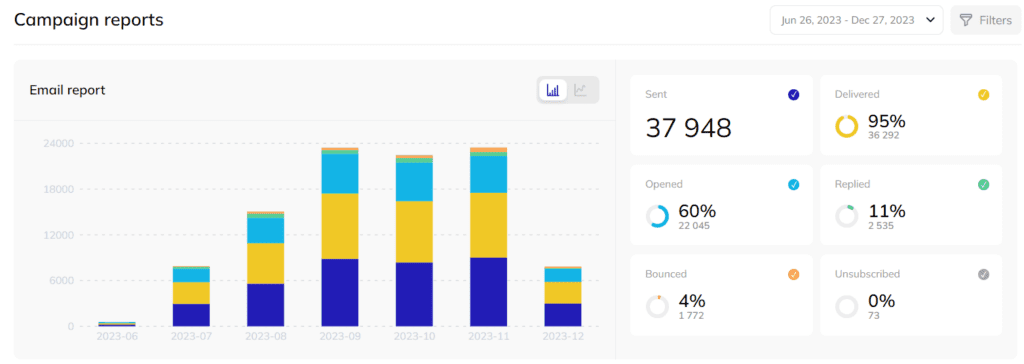
Depending on your PR tactics, the KPIs you should monitor will be different.
They could be podcast appearances, link placements, articles posted, webinars hosted, or any other PR activity that aligns with your goals.
Respona only measures outreach-based metrics, so you might have to resort to using Google Analytics.
If you want to learn more on how to measure the performance of your PR plan, we have a whole guide dedicated to that as well.
The 4 Best PR Tools to Use as Part of Your PR Strategy
As a little bonus, we have also prepared 4 of the best PR tools useful for both marketers and public relations specialists.
These cover all of the main processes that PR involves, from prospecting and outreach to brand mentions and communication with journalists.
Tool #1: Respona
I already described how to use Respona for running a PR campaign, but it can be used for automating all kinds of outreach, be it marketing, public relations, sales, or even for press release distribution.
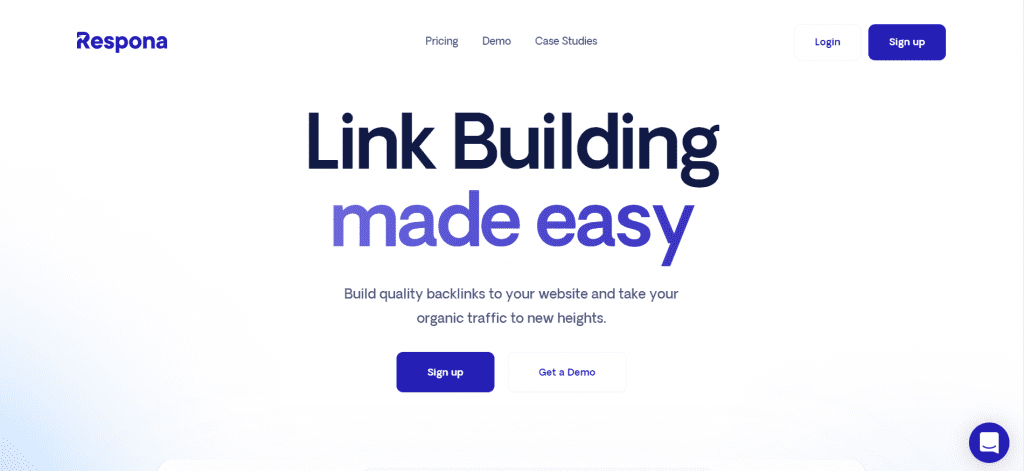
Encompassing all of the necessary functionality to do everything from prospecting to sending out automatic follow-ups without having to use any other outreach or email finding tool, it will be of great help to everybody dealing with outreach.
Tool #2: Ahrefs Alerts
I also already spoke about Ahrefs, but I didn’t mention its Alerts functionality.
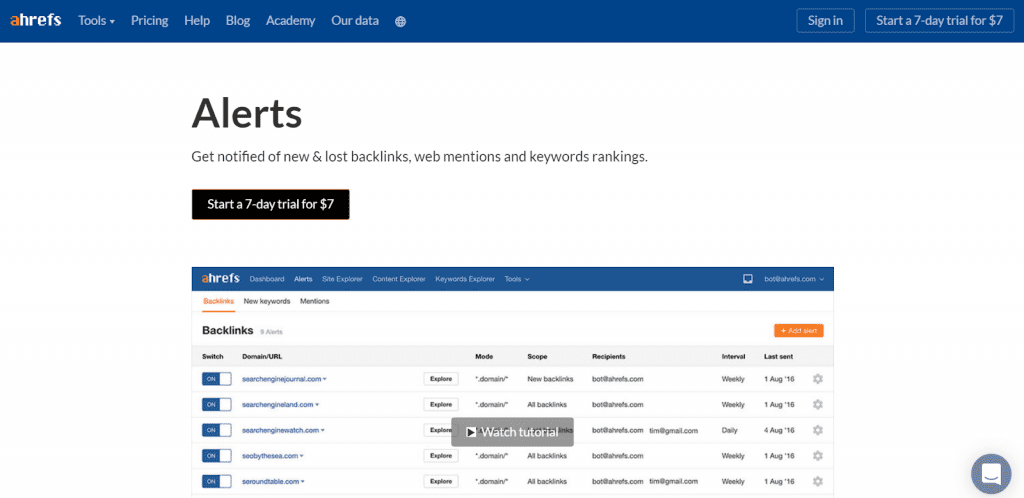
Ahrefs Alerts is great for tracking mentions of your keyword, and, more specifically, your own brand.
You can set the frequency at which it crawls the web for mentions, and have daily, weekly, bi-weekly, or monthly alerts delivered directly to your inbox.
These reports are extremely helpful for prospecting, and by checking them from time to time, you will reveal some amazing PR opportunities.
Tool #3: SparkToro
And while SparkToro can primarily be used for content marketing or influencer marketing, the tool can undeniably be useful for public relations purposes as well.

It is one of the best and most functional tools for market research and audience intelligence, and it also provides the most accurate and relevant data.
With it, you can conduct searches to identify audiences based on their online activities, and easily create lists of media contacts to connect and reach out to.
Built by Rand Fishkin, the founder of Moz, it needs no introduction as it is simply a tool with no alternatives.
Link building cheat sheet
Now Over to You
So, there you have it.
You now have the foundation for developing a successful PR strategy for your business.
We hope that the five steps outlined above will help you launch PR campaigns that will get you the attention you need.
If you’re ready to start with your digital PR strategy, don’t forget to take a look at Respona.
Our public relations tool is used by many startup companies trying to get PR coverage and raise awareness for their brand.
Just ask for access to a demo and we’ll be glad to show you what Respona can do for you.






